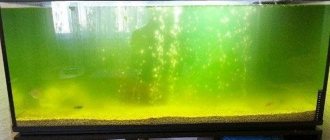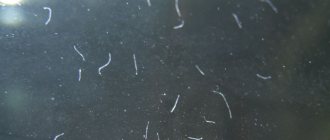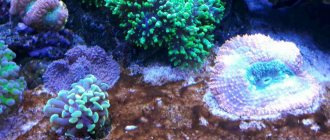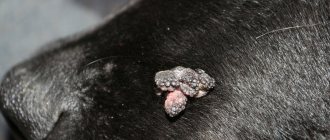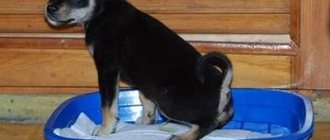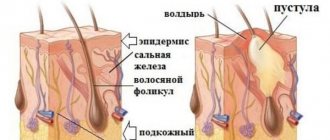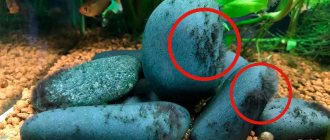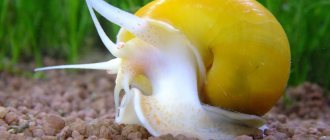Why is it dangerous?
Filamentous algae can entangle an aquarium of any size in a few days. At the same time, they release substances into the water that harm other plants and the inhabitants of the underwater world, including their destruction.
Consequences of the growth of filamentous algae:
- By entangling plant leaves and moss rhizoids, the filaria blocks their access to light, which is vital for growth and development.
- Partial death of the filament becomes a source of toxic substances, the concentration of which quickly increases and kills living creatures.
- When entangled in thread-like shoots , small fish and fry die.
- The water becomes dirty and cloudy.
The process also has a positive side. The appearance of filaria in a home pond is a marker of a favorable environment for the development of other plants.
What provokes the growth of filamentous tissue:
- Bright lighting - exposure to direct sunlight or artificial light for more than 8 hours a day.
- Low amount of oxygen in water.
- Excess of fertilizers with a small number of plants.
- Poor cleaning of the aquarium and infrequent water changes - nitrates accumulate, which contribute to the growth of filaria.
Filament
In some cases, filament grows when the aquarium is first started, when higher plants have not yet had time to develop and some of the microelements in the water remain unclaimed.
Sometimes you can accidentally “pick up” filament at a pet store.
Methods for removing filamentous algae from an aquarium
You can combat filament by simply removing it or using special products. Thin algae are easily removed from the water using a stick with a rough surface on which they need to be wound. Some aquarists use a clean toothbrush for this purpose. In addition, it is necessary to create conditions in which the thread does not feel its best.
- It is necessary to reduce the brightness of the lighting. If the aquarium is in bright sunlight, then the glass must be covered with white paper or gauze.
- The filament quickly dies if you create a specially artificial darkening in the aquarium for about three days. That is, the top of the aquarium needs to be covered with a dark cloth.
- Good filters need to be installed.
- The water in the aquarium needs to be replaced, and all plants, stones, and equipment must be washed.
- There should be more plants in the aquarium. The more plants there are in the water, the less nutrients the algae get.
- Algae eagerly devour some types of fish. These include molly, loricaria, ancistrus, Siamese algae eaters, and girinocheilus. Neretina snails are excellent at cleaning plants from algae.
The listed control methods usually help restore balance in the aquarium. If these methods do not help, then you can purchase special chemicals. The most commonly used product is Tetra Algumin; it must be used strictly in accordance with the instructions.
Before purchasing an aquarium and its inhabitants for the first time, you always need to first find out what plants are recommended to be used for planting in the ground, what equipment and what conditions are considered optimal for the growth and development of all living creatures. This will allow you to avoid the most serious and common mistakes that affect the appearance of filamentous algae.
Types and external signs
Under the name filamentum lies several types of algae that differ from each other in characteristics that are identified only upon detailed examination under a microscope. Control measures depend entirely on what variety the plant belongs to, and they must be different.
The following are often found in aquariums:
- Oedogonium is the most common type of filament, which initially looks like fluff on plants. Over time it grows into long green threads. The appearance of this species, first of all, signals depletion of the substrate and lack of nutrients in the water.
- Spirogyra looks like a nasty green slime that multiplies very quickly.
- Rhizoclonium is a frequent guest in new aquariums with an unstable biobalance. As long as ammonium levels are high and nitrite levels are low, it will feel excellent, and when microbiological indicators stabilize, it will disappear by itself.
The general features of filamentous algae are that they look like thin green threads and feel soft and slimy to the touch. If you take them out of the water, they sag.
The alga Cladophora is often classified as a filaria. However, experts consider this opinion to be erroneous. This plant is hard to the touch and has an elastic structure that remains exposed to air. Cadophora appears in places where water stagnates or is poorly filtered.
Classification of algae
Filament is represented by a wide variety of species. Each of them must be dealt with individually. If it is possible to determine the specific type of parasite, this will allow us to quickly move on to its immediate elimination.
The main algae are:
There are several varieties of filament that may indicate a problem.
How to get rid of filament in an aquarium?
It is extremely difficult to remove slimy green algae, since the slightest particle can give rise to new “shoots”. Filament in an aquarium, how to deal with it depends on the reasons for its appearance, in some cases can become a real disaster.
Control measures:
- At the first sign of the appearance of filament in the aquarium, you should catch all visible threads . It is convenient to wrap them around a stick or a small brush or toothbrush.
- well .
- Good aquarium cleaners are Siamese algae eaters, molynesias or Amano shrimp, which happily eat filament. To make the process go more smoothly, it is necessary to keep the animals on a small diet.
- When edogonium appears in the water, you should feed the plants , which themselves will become the most effective means of control. You should not change the water frequently. A lack of nutrients will only further provoke its growth.
In addition, you can use drugs to combat filament - algaecides. Processing is carried out strictly according to the instructions.
Important! If the aquarium maintains artificial lighting, you should pay close attention to the color of the lamps - blue light stimulates the rapid growth of filamentous algae, it is better to use another one with a softer yellow radiation.
filamentous algae
Ways to solve the problem
Before you take active action, you need to determine why the green tufts appeared. After eliminating the main factor that provokes the growth of these organisms, you can achieve victory over the filament. First of all, it is necessary to destroy the algae. The cleaner the pond, the better.
Use magnetic graters and scrapers. But the best thing is a dishwashing sponge. Driftwood, filters and decorative elements can be washed well with it. To do this, use an old toothbrush. It is ideal for this procedure, as it is small in size and equipped with stiff bristles. It can be used to disinfect even hard-to-reach areas.
To get rid of filamentous algae in an aquarium, specialized means are used, among which the most widespread are:
- Sidex;
- ApiAlgafix;
- Tetra Algesit.
To clean and disinfect an aquarium, use a regular sponge and specialized products.
There are also other methods for solving the problem. Hydrogen peroxide is effective against filamentous bacteria. It is permissible to use no more than 40 ml of this product per 100 liters of water. They draw it into a syringe and direct it to the area where the parasitic plant is located. Peroxide does not have a negative effect on fish and other inhabitants of the aquarium.
It is impossible to figure out how to deal with filamentous algae in an aquarium until the condition of the aquarium is analyzed. Getting rid of the pest is not easy. Even a small thread can quickly spread and fill the entire space.
But by following simple recommendations, you will be able to solve this problem. When selecting plants for a future aquarium, as well as decorative decorations, you should carefully inspect them before placing the tank. There may already be threads on them, and they need to be quickly removed.
For higher plants, a comfortable environment should be created. If for some reason this is not possible, you will have to resort to the use of specialized compounds. High-quality aeration is very important for the supply of oxygen to all inhabitants of the aquarium. The amount of nitrates and phosphates should be adjusted.
It is also important to monitor the lighting. Let's say the light period is no more than 8 hours. It is better to move the aquarium, which is in a sunny place. Feed volumes should also be reduced. It is better to give it gradually so that pieces of food do not remain in the container. It is good to allow shrimp and algae-eating creatures into the pond. They will destroy the thread pretty quickly.
Prevention measures
It is easier to prevent any disease than to cure it later. This rule is also true in the case of uncontrolled proliferation of filamentous algae. Their very appearance is a signal for the aquarist: plant oppression has begun due to an imbalance of nutrients - there are many of some, and not enough of others.
To prevent an algal “apocalypse,” there are simple preventive measures:
- The filament often sticks to other plants - you can bring it into an aquarium with freshly purchased algae. It is necessary to carefully inspect and wash the new “tenants”, clearing them of all suspicious threads.
- Regularly perform hygiene procedures in the aquarium - cleaning and changing water. otherwise, decay products, nitrates, accumulate, which become fertile “soil” for the development of filament.
- Lighting control. If the aquarium is exposed to direct sunlight, it is better to find another place for it. Artificial light is supplied for no more than 12 hours. This time is enough for the development of plants and fish.
- Vegetation balance - if there are few “cultivated” plants, the free space will be occupied by uninvited filamentous guests.
- Regular high-quality aeration. Well-performing plantings will suppress green algae growth.
- Feeding the inhabitants of a home pond is within the norm - leftover food often becomes a favorable environment for the reproduction of filamentous fish. It is better to give the food in parts so that it does not fall to the bottom.
Blackout
Pros:
- the method destroys not only filamentous algae, but also other types of algae, leaving them practically no chance.
Minuses:
- darkening can kill aquarium plants, especially those that require good lighting.
Darkening the aquarium is used by many experienced aquascapers.
Before the procedure you must:
- Remove as much algae as possible mechanically.
- Trim overgrown plant leaves.
- Siphon the aquarium, clean the filter, change the water by 50-70%.
- Turn off the lights and carbon dioxide supply.
- Turn on filtration and completely darken the aquarium.
- In case of severe infestation, you can add a product containing an algaecide and then wait three days.
During this time, the algae will die, but the plants and living inhabitants will remain unharmed. The aquarium is fully launched on the fourth day. If there is too much dead algae in the tank, they should be removed with a net and the filter should be rinsed thoroughly to prevent the release of ammonium. Turn on the lighting and CO2 supply - first to a minimum, then gradually increase over several days. To restore normal plant growth, add nitrogen and phosphorus.
Ruslan Ivanyushin (aka naman)
Russian aquascaper
Filamentous hair was once thought to be caused by high iron levels, but this is not true. If you reduce the dose of the microelement to 0.1 mg/l, the algae will not die, but the plants will begin to experience chlorosis, a disease associated with Fe deficiency, from which they will stop growing.
